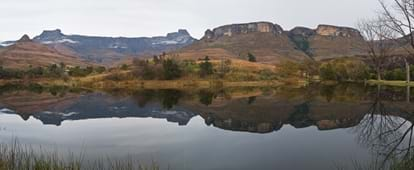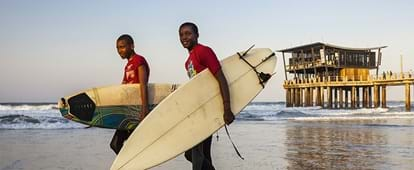By creating an account, I agree to the
Terms of service and Privacy policy
Choose your country and language:
Africa
Americas
Asia Pacific
Europe
TThe warm Indian Ocean to the east and the Drakensberg mountains to the west border KwaZulu-Natal, South Africa’s self-styled playground province, home to two World Heritage Sites: the iSimangaliso Wetland Park and the uKhahlamba-Drakensberg Park.

TThe 332 000-hectare iSimangaliso Wetland Park features three lake systems, eight ecosystems, swamp forests, pristine reefs, Africa’s largest estuarine system, more than 500 bird species and some of the highest sand dunes in the world.
The imposing mountain range of the uKhahlamba-Drakensberg Park is celebrated for its San rock art as well as its beauty. More than 30 000 symbolic paintings adorn the walls and overhangs of 500 caves scattered throughout this extensive and ancient rocky landscape.

TThe 332 000-hectare iSimangaliso Wetland Park features three lake systems, eight ecosystems, swamp forests, pristine reefs, Africa’s largest estuarine system, more than 500 bird species and some of the highest sand dunes in the world.
The imposing mountain range of the uKhahlamba-Drakensberg Park is celebrated for its San rock art as well as its beauty. More than 30 000 symbolic paintings adorn the walls and overhangs of 500 caves scattered throughout this extensive and ancient rocky landscape.
In and around the town of Ladysmith in the northern hinterland lies the historic battlefields region, which has witnessed much spilling of blood. Zulu warriors, Boer garrisons and British troops clashed in many skirmishes in the region during the late 1800s. The most famous of these was the 118-day siege of Ladysmith during the South African (Anglo-Boer) War.
Culturally speaking, KwaZulu-Natal is a mix of Zulu, Indian and colonial influences, with each heritage reflected in historical and cultural trails, architecture, township cuisine and Durban’s fine Indian curries.
Game and nature reserves, unspoilt beaches and the iSimangaliso Wetland Park dominate the Elephant Coast north of the port city of Durban, while the Sapphire and Hibiscus coasts to the south comprise small holiday towns, holiday accommodation and numerous blue flag beaches.

AAbout two hours’ drive inland from Durban, Nottingham Road marks the heart of the Midlands Meander, a country setting for more than 100 art and craft outlets, B&B and hotel accommodation, adventure sports destinations, pubs, farm-style and upmarket eateries, hiking and horse trails, and quaint getaway spots.
A sun-worshipper’s dream by day and a party destination by night, the beachfronts of Durban and Umhlanga come alive with clubs, pubs, live music, lounges and restaurants vying for patronage. Greater Durban’s Florida Road and Helen Joseph Road are popular meeting places for the young and trendy, where a strip of bistros and restaurants offer international and local cuisine.
Larger shopping malls in the province include Umhlanga’s Gateway; the Galleria in Amanzimtoti; the Midlands Mall in Pietermaritzburg; Westville’s Pavilion; the Dolphin Coast Centre in Ballito; Musgrave Centre in Durban; La Lucia Mall in La Lucia; and the Shelley Mall on the lower South Coast.
Around 11.4-million South Africans, attracted by the largely warm subtropical climate (hot, humid summers and dry, clear winters), call this province home.
TTravel tips & planning info
Who to contact
KwaZulu-Natal Tourism Authority
Tel: +27 (0)31 366 7500
Email: enquiries@zulu.org.za
Ezemvelo KZN Wildlife
Tel: +27 (0)33 845 1000
Email: bookings@kznwildlife.com
How to get here
Fly in from any of South Africa's major cities to King Shaka International Airport just north of Durban. If you’re driving, from Johannesburg take the N3 highway, which takes you through the province; and from Cape Town, take the N2 highway to Durban.
Best time to visit
KwaZulu-Natal is an all-year-round destination due to its warm climate. The coastal regions have hot, humid summers with high rainfall. Inland, summers are warm and winters mild, while around the Drakensberg mountains, winters are cold with frequent snowfalls.
Things to do
The Midlands Meander route; uShaka Marine World in Durban; birdwatching in Zululand; game reserves of the Elephant Coast; the Battlefields route; the Freedom route MTB coast-to-coast challenge.
What to pack
All you need any time of the year is warm weather clothing. Pack light cotton or linen clothes, short sleeve shirts, shorts, sundresses, hats and swimsuits. A simple cardigan or jacket for cooler evenings should be all that is required, unless you are visiting the Drakensberg mountains in the wintertime!
What to eat
Famous Durban curries and bunny chow (a bread and curry dish); traditional Zulu fare at cultural villages; and traditional South African cuisine at the game reserves.
Related links

